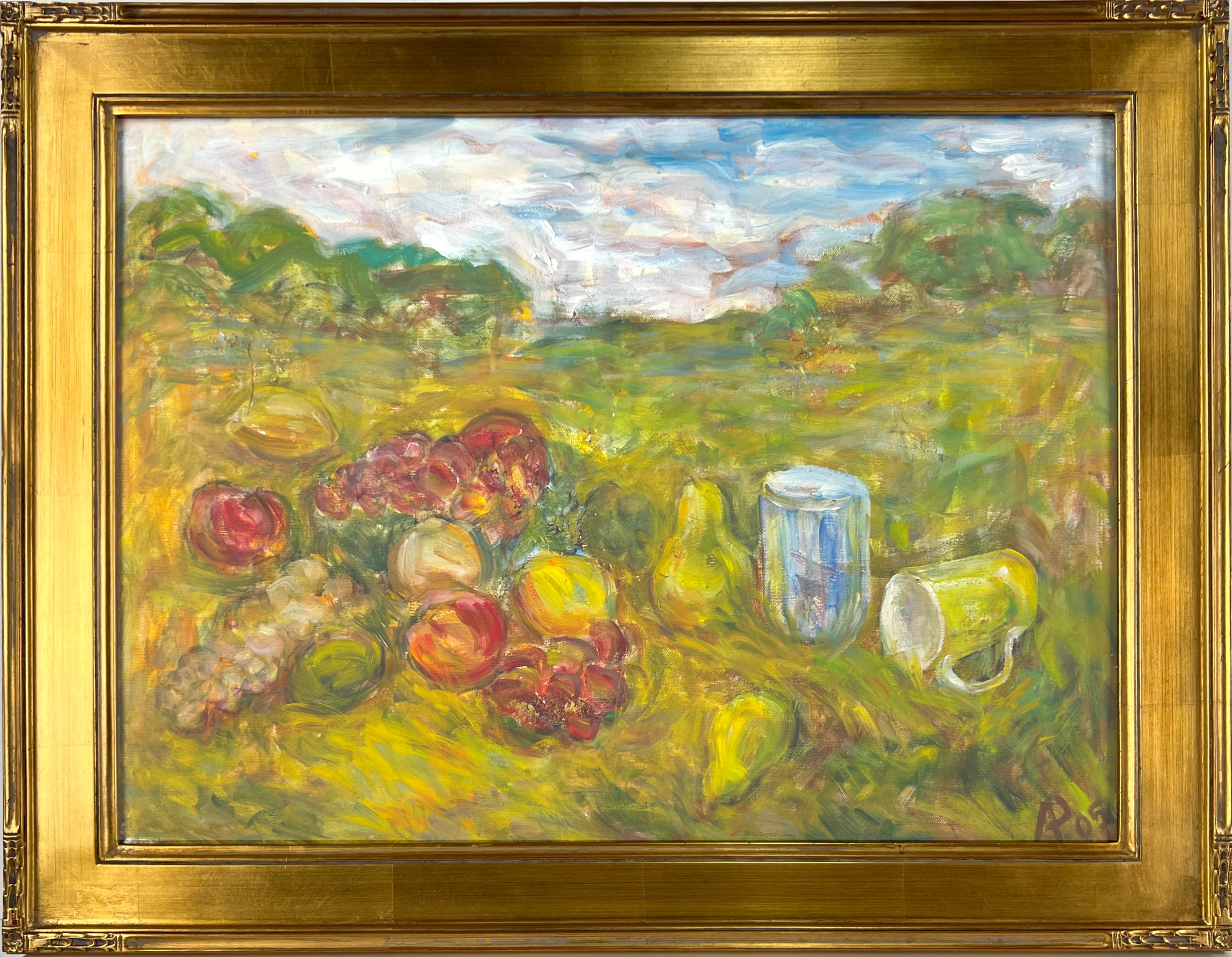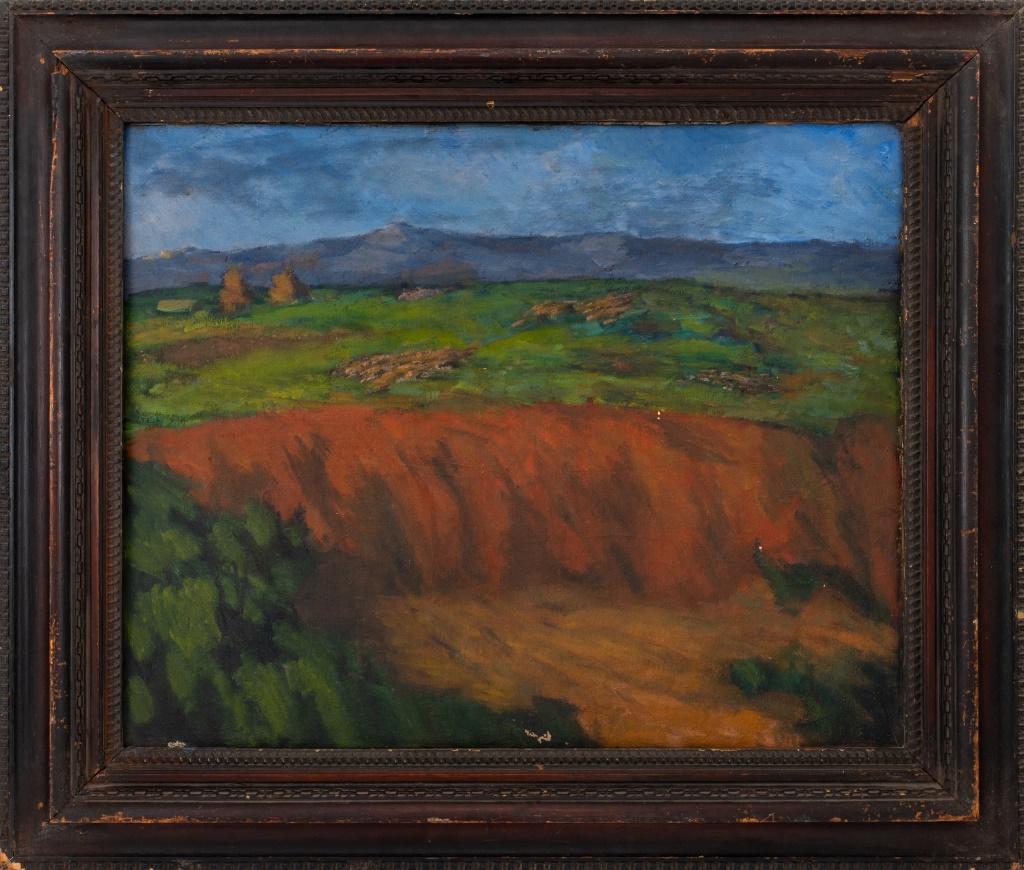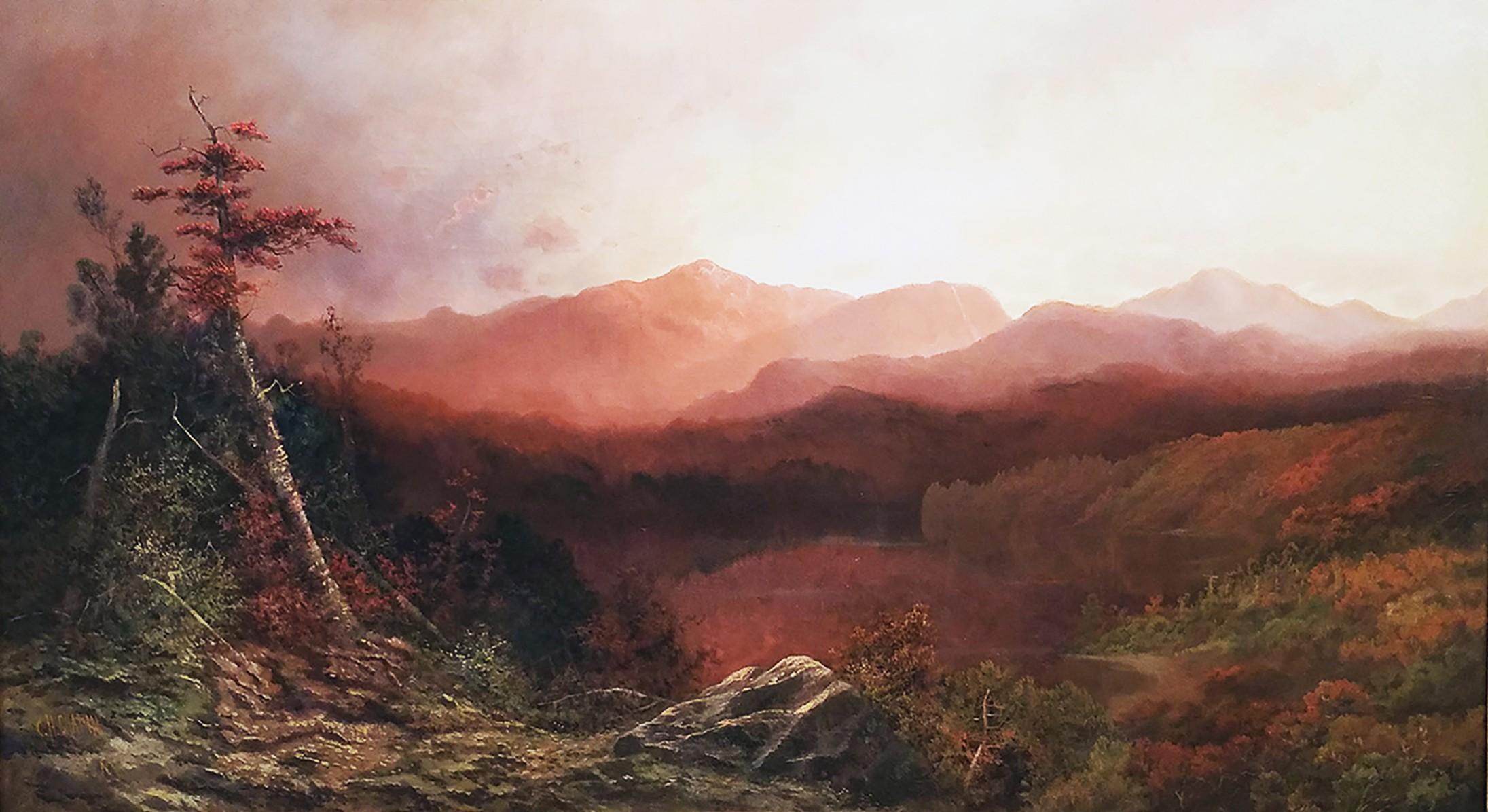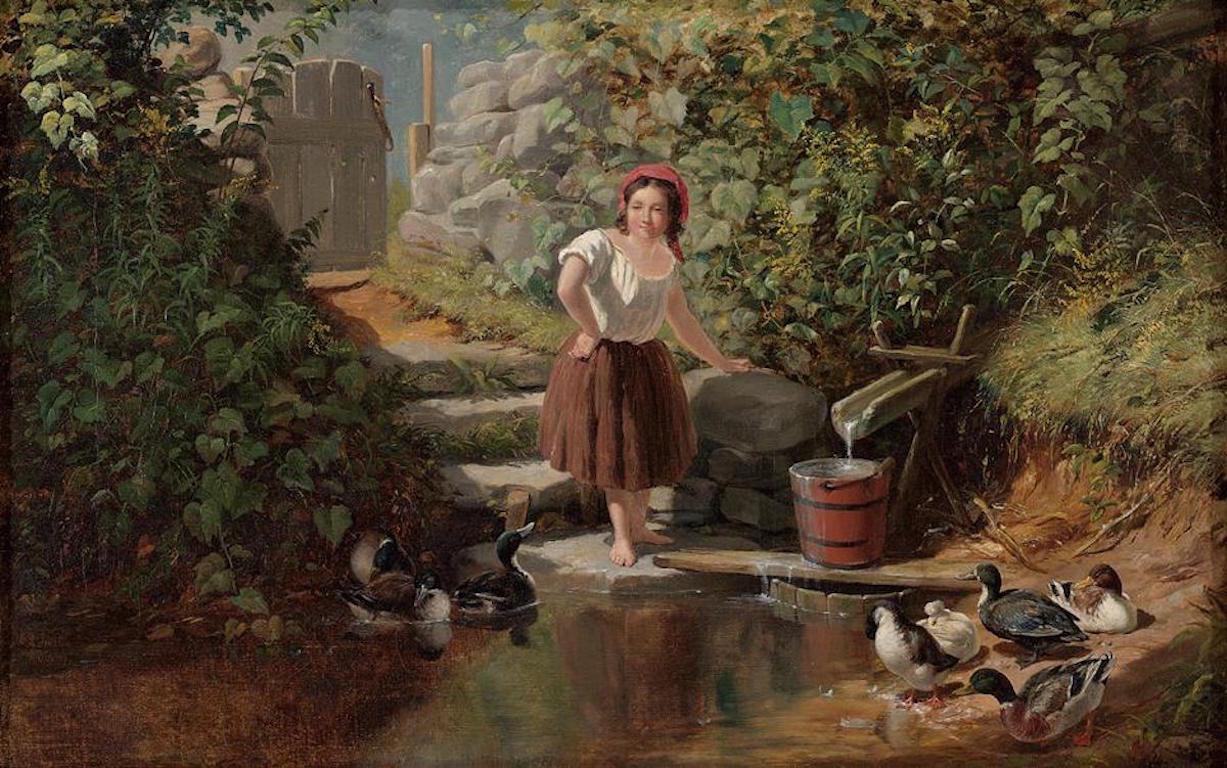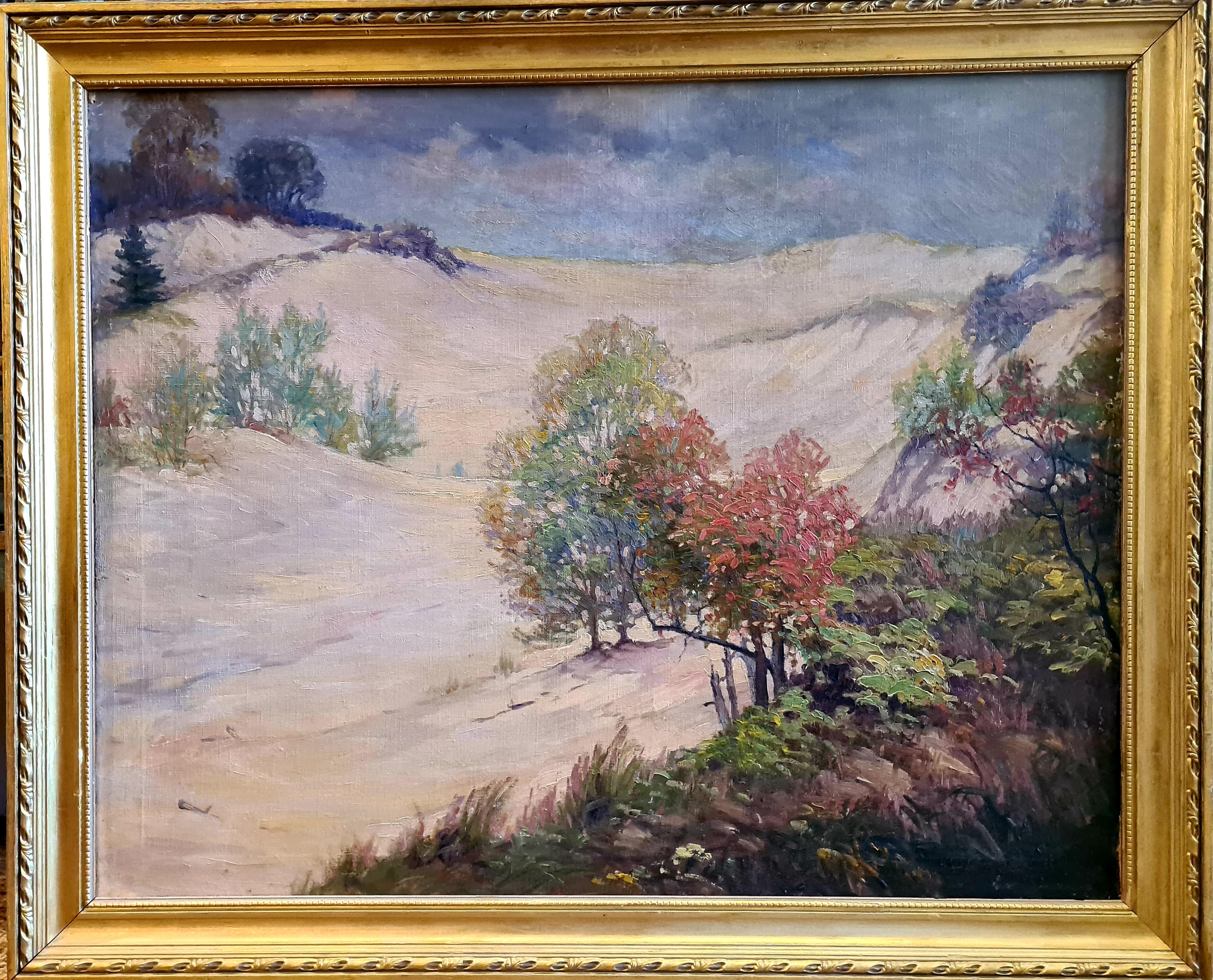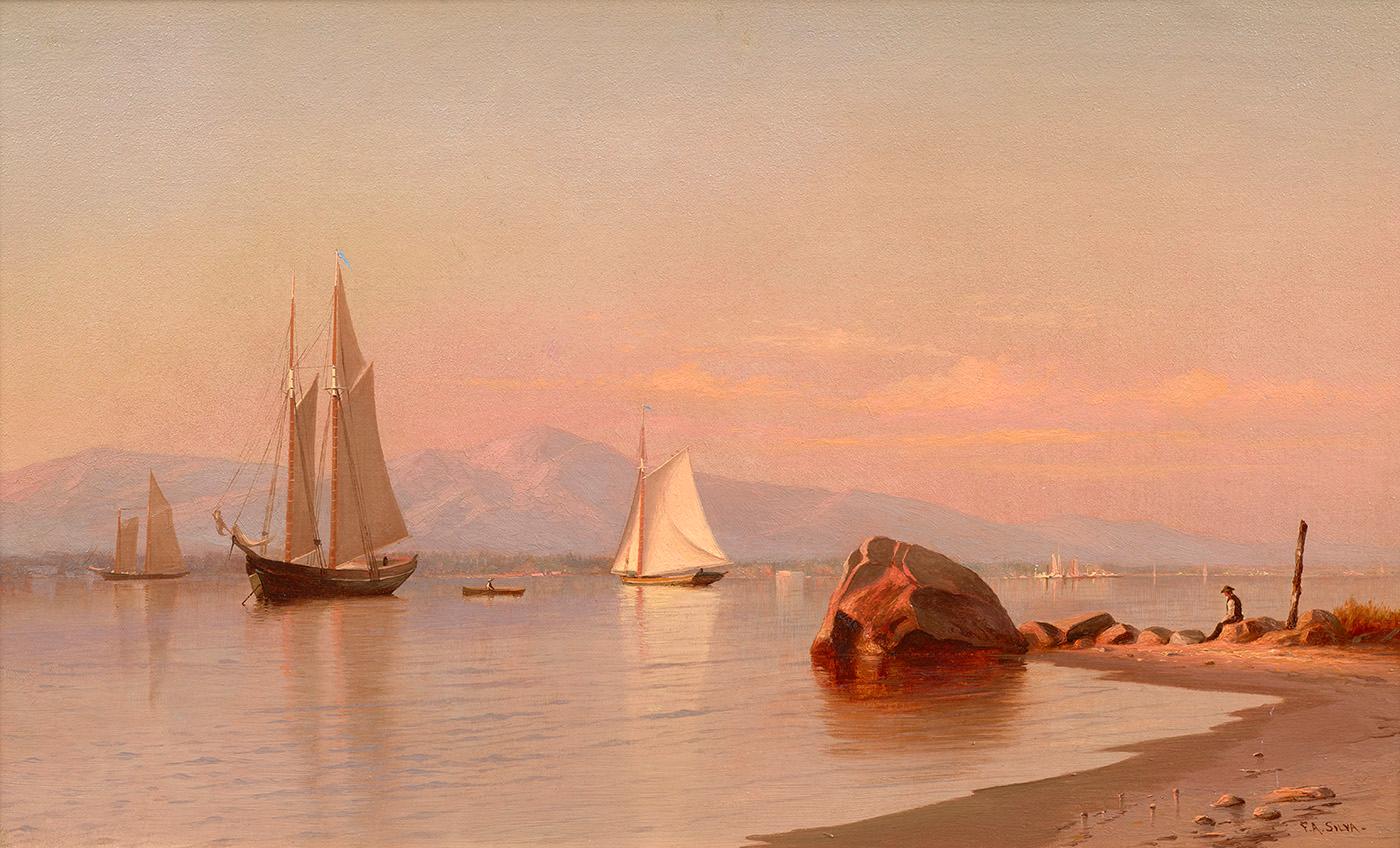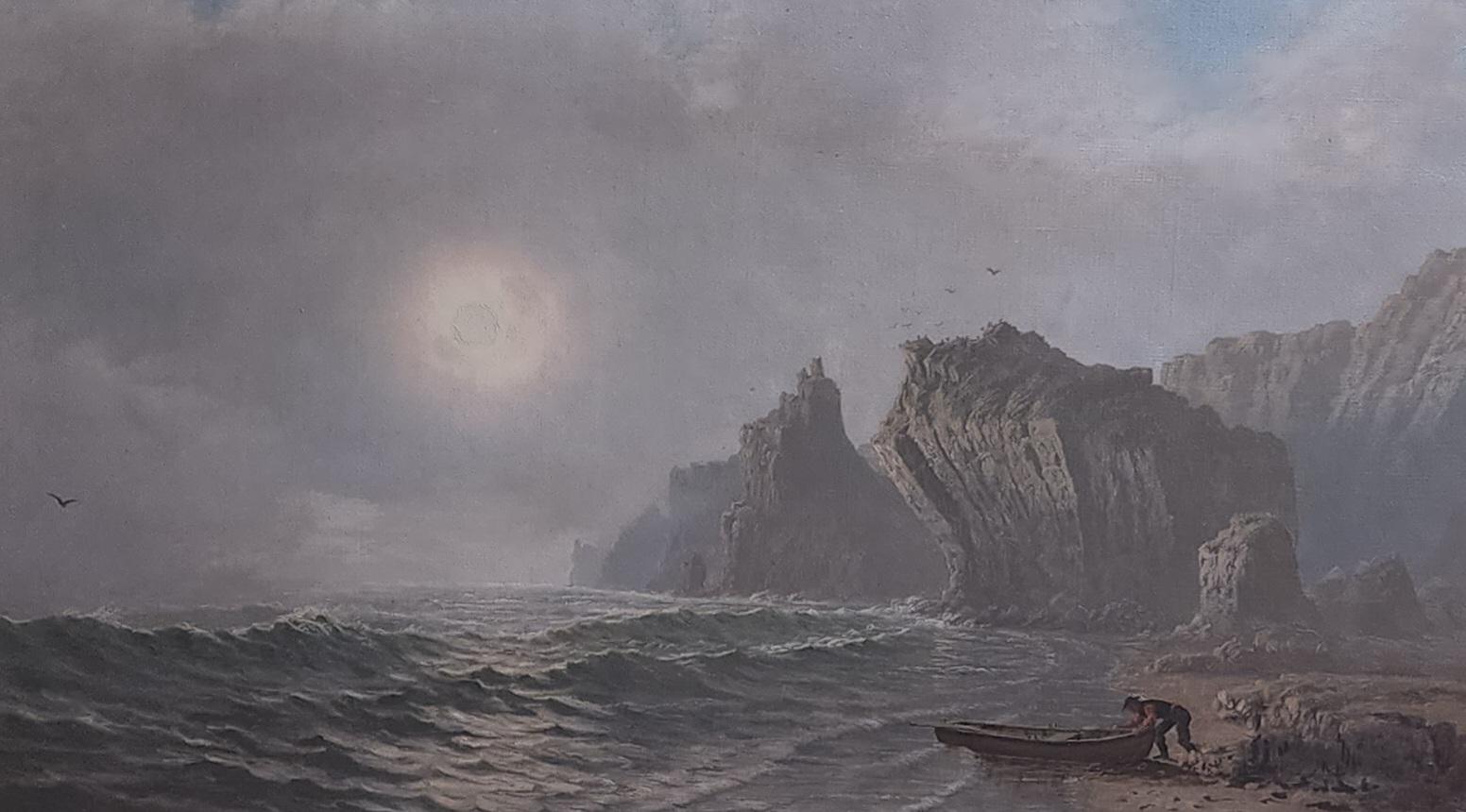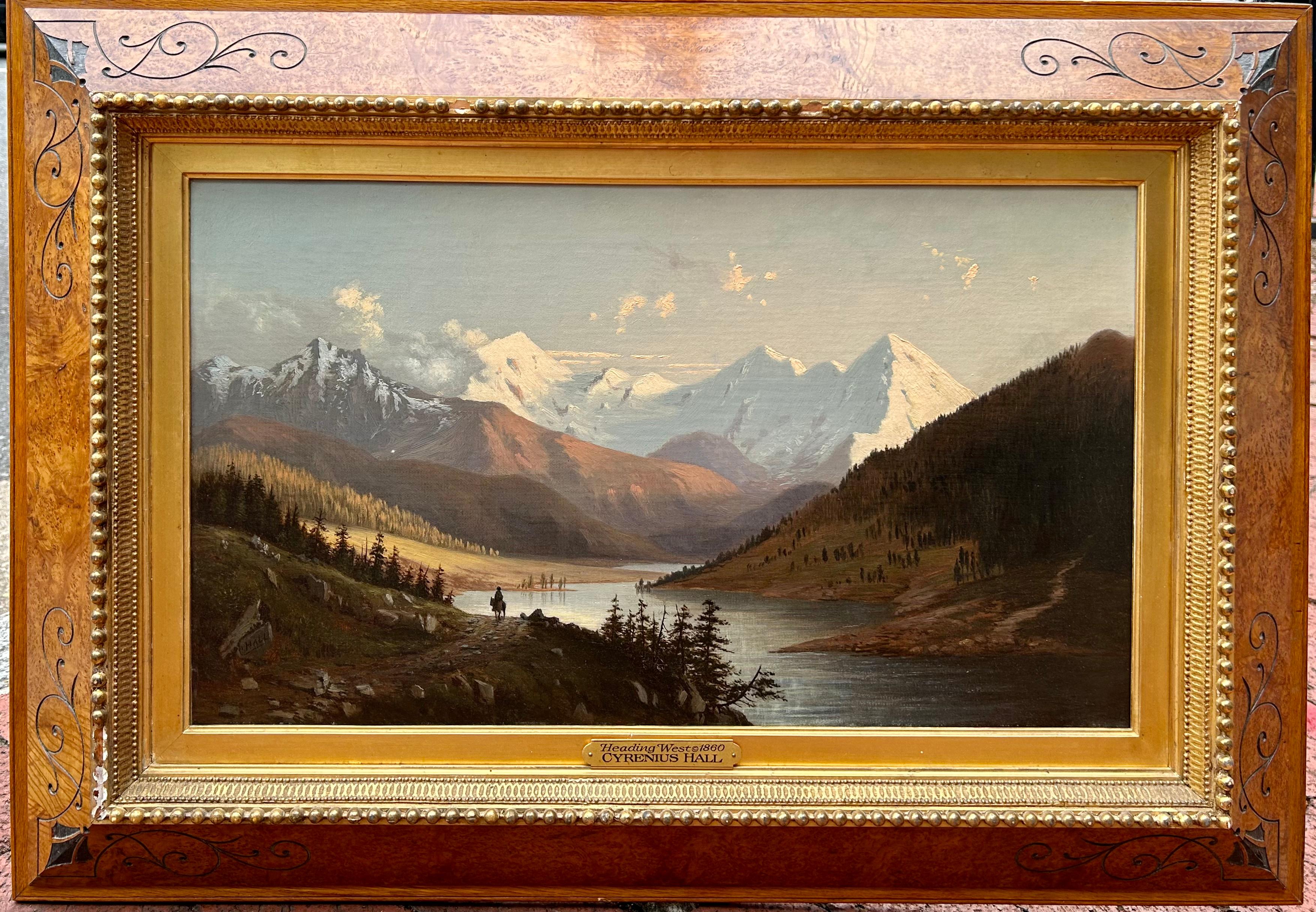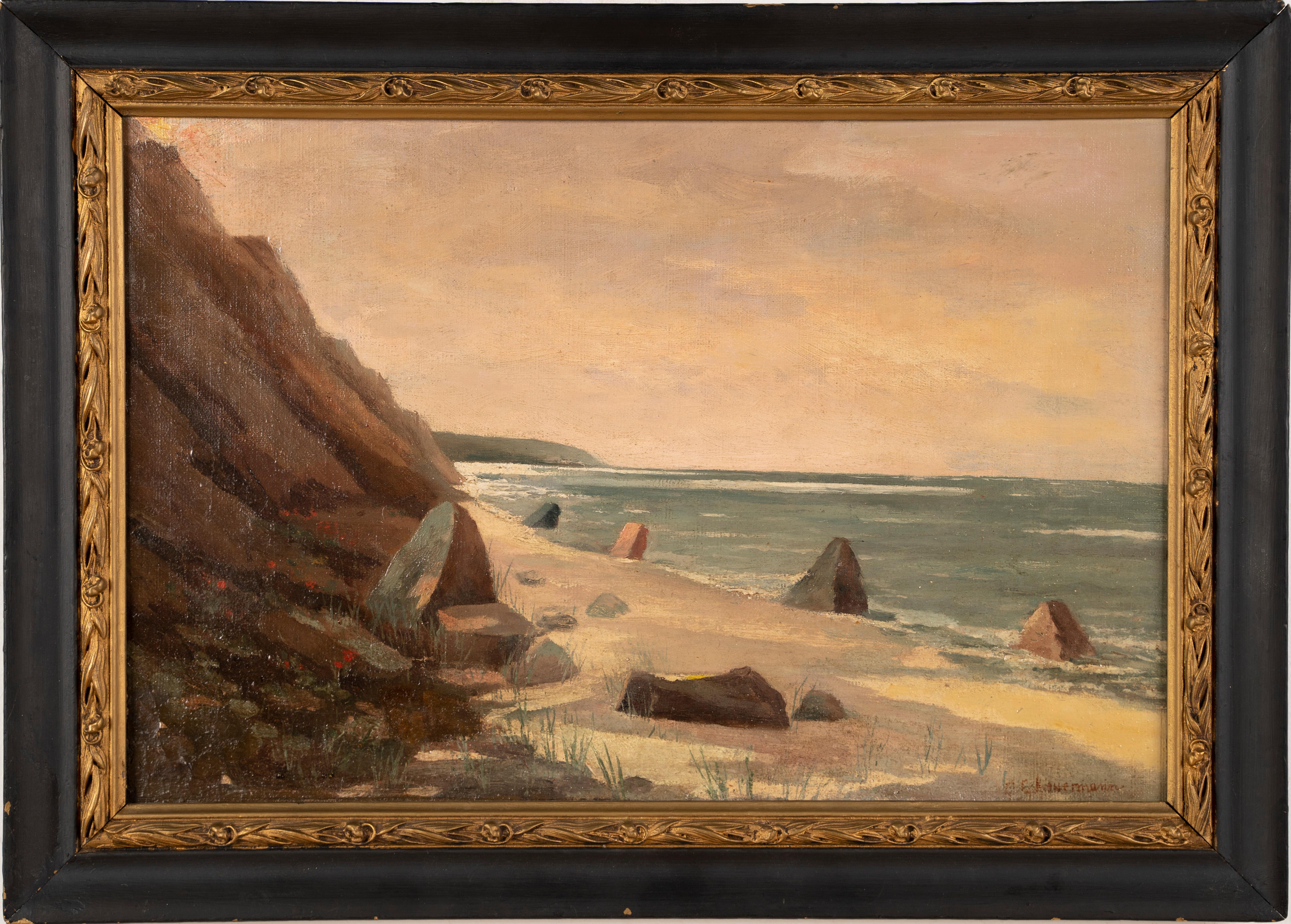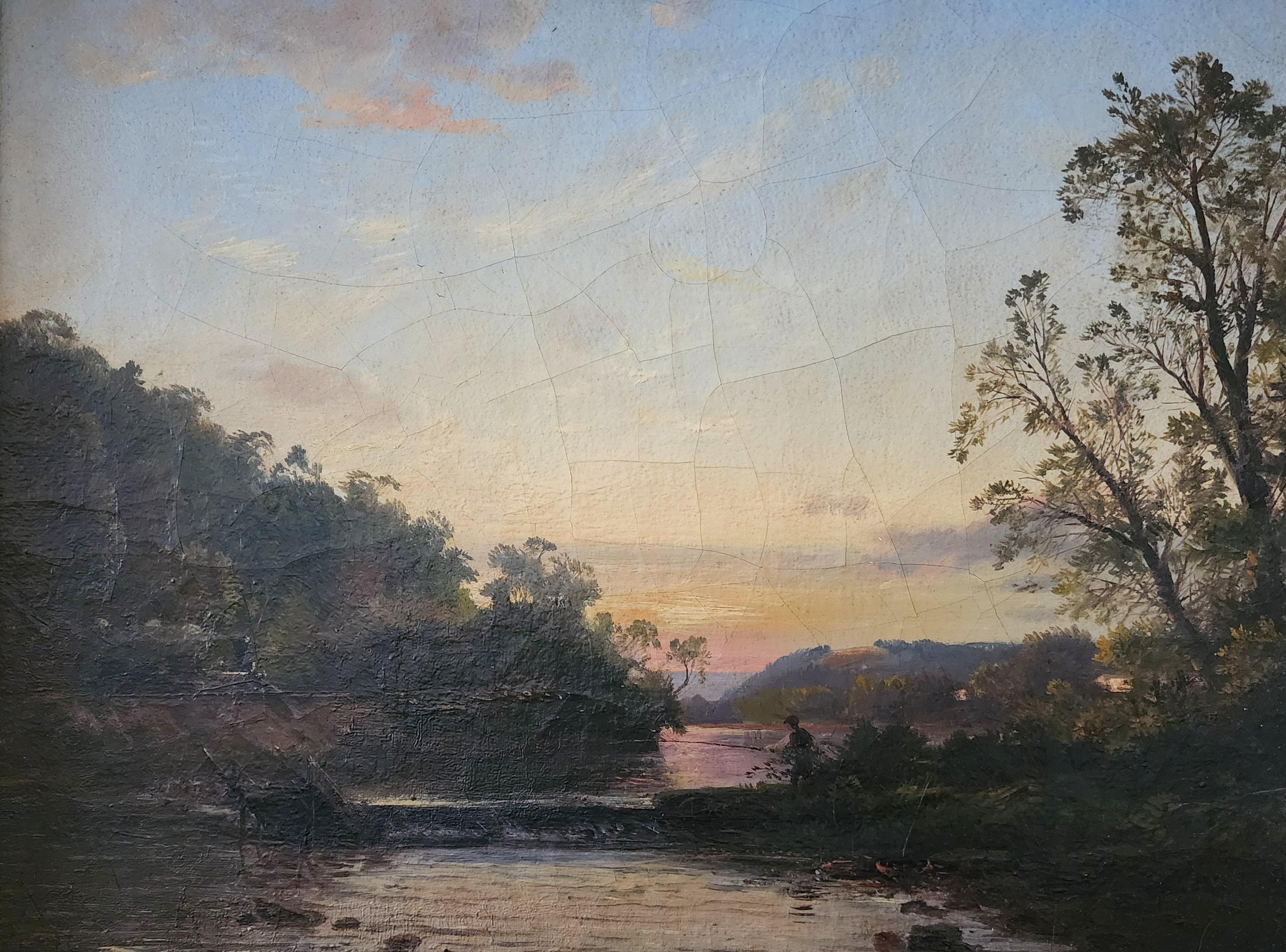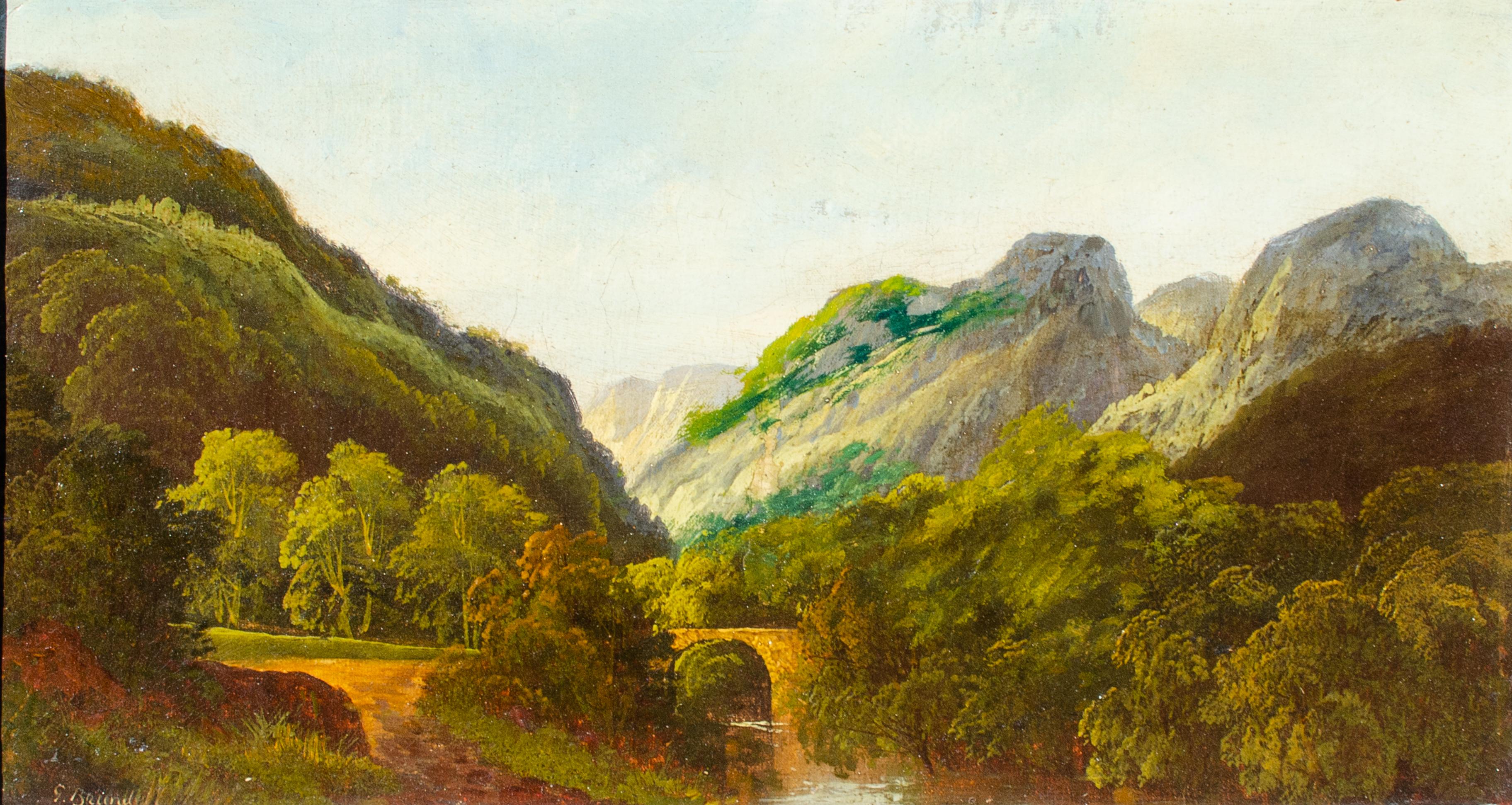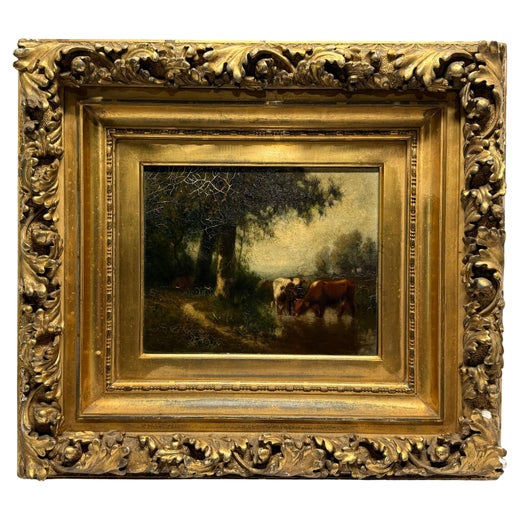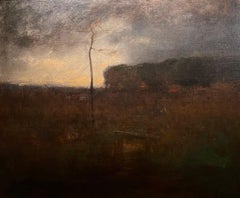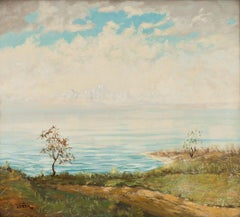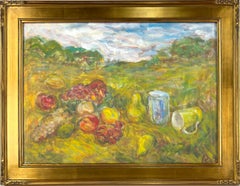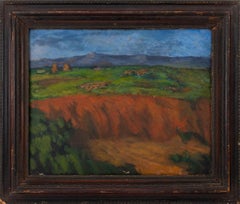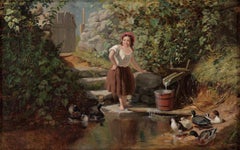"Keene Valley, Adirondack Landscape" William Hart, Hudson River School Landscape
View Similar Items
Want more images or videos?
Request additional images or videos from the seller
1 of 9
William Hart"Keene Valley, Adirondack Landscape" William Hart, Hudson River School Landscape1873
1873
About the Item
- Creator:William Hart (1823 - 1894)
- Creation Year:1873
- Dimensions:Height: 25 in (63.5 cm)Width: 32 in (81.28 cm)
- Medium:
- Movement & Style:
- Period:
- Condition:
- Gallery Location:New York, NY
- Reference Number:1stDibs: LU184129924512
William Hart
Born in Scotland, William Hart emigrated with his family to New York on the ship Camillus in 1830. He became known for serene, bucolic and romantic landscapes. Many of his paintings had cattle and realistic figures diminished in the landscape, a motif he began in the late 1880s. Hart was a second generation "Hudson River School" painter. George Inness and Asher Durand were major influences, although he was basically self-taught.
About the Seller
5.0
Platinum Seller
Premium sellers with a 4.7+ rating and 24-hour response times
Established in 2022
1stDibs seller since 2022
104 sales on 1stDibs
Authenticity Guarantee
In the unlikely event there’s an issue with an item’s authenticity, contact us within 1 year for a full refund. DetailsMoney-Back Guarantee
If your item is not as described, is damaged in transit, or does not arrive, contact us within 7 days for a full refund. Details24-Hour Cancellation
You have a 24-hour grace period in which to reconsider your purchase, with no questions asked.Vetted Professional Sellers
Our world-class sellers must adhere to strict standards for service and quality, maintaining the integrity of our listings.Price-Match Guarantee
If you find that a seller listed the same item for a lower price elsewhere, we’ll match it.Trusted Global Delivery
Our best-in-class carrier network provides specialized shipping options worldwide, including custom delivery.More From This Seller
View All"Grand Manan" Harrison Bird Brown, Maine Landscape, Hudson River School Seascape
By Harrison Bird Brown
Located in New York, NY
Harrison Bird Brown (1831 - 1915)
Grand Manan
Oil on canvas
12 x 20 inches
Signed with initials lower left
Harrison Bird Brown was born in 1831 in Portland, Maine, and is best known for his White Mountain landscapes and marine paintings of Maine's Casco Bay...
Category
Late 19th Century Hudson River School Landscape Paintings
Materials
Canvas, Oil
Rapelyea House, New York, William Rickarby Miller, Hudson River School Landscape
By William Rickarby Miller
Located in New York, NY
William Rickarby Miller
Rapelyea House, New York, 1884
Signed and dated lower left
Oil on canvas
20 x 30 inches
Provenance:
Kennedy Galleries, New York
Born in Staindrop, County Durham, England, he was a portrait and landscape painter, especially appreciated for watercolor painting, which he sold through the American Art Union...
Category
1880s Hudson River School Landscape Paintings
Materials
Canvas, Oil
"A Cloudy Day, " View of Montclair, New Jersey, Tonalist, Barbizon Scene
By George Inness
Located in New York, NY
George Inness (1825 - 1894)
A Cloudy Day, 1886
Oil on canvas
25 x 30 inches
Signed and dated lower center
Provenance:
The artist
Estate of the above
Fifth Avenue Galleries, New York, Executor's Sale of Paintings by the Late George Inness, N.A., February 12 - 14, 1895, Lot 132
Joseph H. Spafford, acquired from the above
Mrs. Spafford, by bequest from the above
Leroy Ireland, New York, 1951
Ernest Closuit, Fort Worth, Texas
Meredith Long & Company, Houston, Texas, circa 1960
Private Collection
Shannon's Fine Art, American and European Fine Art Auction, October 27, 2016, Lot 42
Exhibited:
New York, American Fine Arts Society, Exhibition of the Paintings Left by the Late George Inness, December 27, 1894, no. 90.
Literature:
LeRoy Ireland, The Works of George Inness: An Illustrated Catalogue Raisonne, Austin, Texas, 1965, p. 336, no. 1324, illustrated.
Michael Quick, "George Inness: A Catalogue Raisonne," Vol. II, New Brunswick, New Jersey, 2007, pp. 282-83, 311, no. 966, illustrated.
George Inness, one of America's foremost landscape painters of the late nineteenth century, was born in 1825 near Newburgh, New York. He spent most of his childhood in Newark, New Jersey. He was apprenticed to an engraving firm until 1843, when he studied art in New York with Regis Gignoux, a landscape painter from whom he learned the classical styles and techniques of the Old Masters. In 1851, sponsored by a patron, Inness made a fifteen-month trip to Italy. In 1853 he traveled to France, where he discovered Barbizon landscape painting, leading him to adopt a style that used looser, sketchier brushwork and more open compositions, emphasizing the expressive qualities of nature.
After working in New York from 1854 to 1859, he moved to Medfield, Massachusetts, and four years later to New Jersey, where through a fellow painter he began to experiment with using glazes that would allow him to fill his compositions with subtle effects of light. Duncan Phillips remarked on Inness’s mellow light as a unifying force, saying, “…he was equipped to modernize the grand manner of Claude and to apply the methods of Barbizon to American subjects."
At this time also, Inness developed an interest in the religious theories of Emanuel Swedenborg...
Category
1880s Hudson River School Landscape Paintings
Materials
Canvas, Paint, Oil
"Western Lake Landscape, " John Fery, Hudson River School View
By John Fery
Located in New York, NY
John Fery (1859 - 1934)
Western Lake Landscape, circa 1920
Oil on canvas
21 x 23 1/4 inches
Signed lower left
Provenance:
Private Collection, New York
Born in Austria, John Fery earned a strong reputation for dramatic paintings of western mountain landscape in the United States. Glacier National Park in northwest Montana was a popular subject for him.
He was raised in a prominent, wealthy family that lived on an estate about nineteen miles northeast of Salzburg. His mother was Hungarian, and his father was born in Bohemia. S ome sources have written that he studied art in Dusseldorf, Germany with Peter Jansen, and also in Munich, Venice and Karlsruhe. But his "name does not appear in the records of the major art schools in any of these places, nor is there any record of his name at either the Vienna or Budapest academies." (Merrill 26) It is possible, however, that he received private instruction, and because of the sophistication of his painting, sources think it unlikely that he was self taught.
An early interest in wilderness scenery led him to painting American landscapes and hunting scenes. In the mid 1880s, he came to America and lived in the German community in Milwaukee, and then in 1886, brought his family to the United States. His wife, Mary Rose Kraemer (1862-1940), was born in Switzerland, and they had one child born near Munich and two others born in the United States. From 1886 to 1888, they lived in New York, and by 1890, Fery had made his first trip West.
He visited Yellowstone Park in 1891, and indicated in his writings that he had been there even earlier. From 1892 to 1893, he led European nobility on hunting expeditions to the American Northwest, made possible by the completion of the Northern Pacific Railroad...
Category
1920s Hudson River School Landscape Paintings
Materials
Canvas, Oil
$9,600 Sale Price
20% Off
"Building the Allegheny Railroad, Pennsylvania" Alfred Wall, Scalp Level School
Located in New York, NY
Alfred S. Wall (American, 1825-1896)
Untitled (Building the Railroad), 1859
Oil on canvas
14 1/2 x 18 1/2 inches
Signed and dated lower left
For Christmas, 2008, the Pittsburgh Post-Gazette featured Alfred Wall's painting, Old Saw Mill from the collection of the Westmoreland Museum of American Art in Greensburg, PA. It was painted in 1851 in the town of Lilly, Pennsylvania in the Allegheny Mountains. The newspaper description stated that "though the saw mill is long gone, it still conveys all the warmth and coziness of this time of year. The article, written by Patricia Lowry, continued:
At first glance, Alfred S. Wall's painting of a saw mill in snowy woods triggers nostalgia for the coziness of a log cabin, the smell of a wood-burning fire and the warming of chilled hands and feet beside it.
But as sentimental as it seems on the surface, Mr. Wall's painting has a deeper and unexpected context.
This is more than a painting about sled-riding children and early industry planted in the middle of virgin forest. Intended or not, this is a painting about conquering the great divide of the Allegheny Mountains.
For the third consecutive year, the Post-Gazette features a winter-scene painting on the cover of the Christmas Day newspaper. This year's painting, Old Saw Mill, was selected by co-publisher and editor-in-chief John Robinson Block and executive editor David Shribman during a visit to the Westmoreland Museum of American Art in Greensburg.
Mr. Wall, listed as a portrait painter in the 1850 census, was about 26 when he painted Old Saw Mill in 1851. The self-taught artist was born in Mount Pleasant, Westmoreland County, to William and Lucy Wall, who'd emigrated from England around 1820. An artistic sensibility ran in the family: William was a sculptor who carved ornate tombstones here; Alfred's children, A. Bryan and Bessie, were landscape painters, as was Alfred's older brother, William Coventry Wall. For more than a century the Walls formed a prominent art dynasty in Pittsburgh, and Alfred, eventually a partner in the city's most prestigious art gallery, was well known as a painter, dealer and restorer.
In Old Saw Mill, two wood cutters, each holding an axe, meet outside the mill; one points in the direction of the forest. On the other side of the stream, one child pulls another down the hillside on a sled. Just behind the hill's slope, the roof of a building appears, perhaps the home of the sawyer. The luminous, late afternoon light comes from the northwest, casting lengthening shadows on the snow under a darkening sky.
The saw mill in "Old Saw Mill" likely would have been impossible to track down had Mr. Wall, presumably, not written on the back of the painting: "old saw mill near Jct. 4, Portage RR, Pa."
"There was no Junction 4," said Mike Garcia, park ranger at the Allegheny Portage Railroad National Historic Site, about 90 miles east of Pittsburgh near Gallitzen, Cambria County. "But there was an Inclined Plane No. 4 at Lilly, and there was a saw mill there."
In fact, there were at least six saw mills at Lilly over the years, said longtime resident Jim Salony, president of the Lilly-Washington Historical Society. But when he saw an image of the painting, Mr. Salony had no trouble coming up with a location. While there are no known photographs of the saw mill, he believes it stood near the intersection of Portage and Washington streets, next to Bear Rock Run.
Mr. Salony, retired academic dean at Mount Aloysius College, didn't know exactly when the mill was torn down, but it's been gone since at least the late 1800s. He was pleased to learn of the painting, even though that knowledge came too late for inclusion in a new book about Lilly, The Spirit of a Community, for which he served as primary author and editor. It runs to more than 700 pages. For a little town -- population 869 last year -- Lilly has a lot of history.
Nestled in a bowl on the western slope of the Allegheny Mountains about 3 miles south of Cresson, Lilly was first settled in 1806 by Joseph Meyer and his family, who named their 332-acre land patent Dundee. Although the Meyers had left by 1811, other settlers followed, but the community didn't flourish until the 1830s, when the Allegheny Portage Railroad began its 23-year-run through the town.
For 200 years the Alleghenies had stood as an impediment to trade and travel between Pittsburgh and the east. A canal from Philadelphia to Pittsburgh would change that and compete with New York's Erie Canal. But a portage railroad would have to be built, on which teams of horses would lead the canal boats over the mountains. Engineer Sylvester Welch began his surveying from the small settlement at Lilly. The railroad would require 10 inclined planes, some quite steep, between Hollidaysburg and Johnstown. To build it, trees had to be cut along a 120-foot-wide right-of-way for 36 miles, along which track and engine houses had to be built.
William Brown, who owned the saw mill on Bear Rock Run, built at least one of the engine houses at Inclined Plane No. 4; an 1834 contract also included fencing the dwelling lots at the head and foot of the plane. Lilly is located at what was the foot of Inclined Plane No. 4., giving the community one of its early informal names, Foot of Four.
Named in 1883 for Richard Lilly, who'd completed the grist mill there, Lilly had another early name: Hemlock, so dubbed by a Portage Railroad traveler who smelled the bark stripped from the trees at the saw mill.
Because there isn't another Allegheny Portage Railroad location like it, where a cut in the mountains opens into a bowl, Mr. Salony thinks it was Lilly that Charles Dickens wrote about following his trip from Harrisburg to Pittsburgh on the Pennsylvania Canal in late March 1842, describing what he saw after emerging from "the bottom of the cut": "It was very pretty while traveling, to look down into a valley full of light and softness, catching glimpses through the tree-tops of scattered cabins; children running to the doors; dogs bursting out to bark, who we could see without hearing; terrified pigs scampering homeward; families sitting out in their rude gardens; cows gazing upward with a stupid indifference; men in their shirt-sleeves looking on at their unfinished houses, planning out to-morrow's work; and we riding onward, high above them, like a whirlwind."
To get to Lilly, Mr. Wall may have taken the Pennsylvania Canal from his home in Allegheny City, now the North Side. He'd married young, at 21, to Sarah Carr in 1846, the same year he began his career as an artist. By 1880 they were living in a brick townhouse at 104 (later 814) Arch St., now demolished.
Across the river in Pittsburgh he shared a studio at 67 Fourth Ave. with his brother William; they later moved to Burke's Building, today the city's oldest office building at 209-211 Fourth. But often they worked outdoors, sometimes as part of the colony of artists that grew up around painter George Hetzel beginning in the late 1860s at Scalp Level...
Category
1850s Hudson River School Landscape Paintings
Materials
Canvas, Oil
"Pastoral Landscape, " William Hart, Hudson River School, Cloudy View with Cows
By William Hart
Located in New York, NY
William Hart (1823 - 1894)
Pastoral Landscape, 1877
Oil on canvas
9 1/2 x 14 1/2 inches
Signed and dated lower left
Born in Paisley, Scotland, William Ha...
Category
1870s Hudson River School Landscape Paintings
Materials
Canvas, Oil
You May Also Like
Picnic in the Vineyard Spring Contemporary French Impressionist Style Landscape
By Alexandr Rapoport
Located in Soquel, CA
Spring Picnic in the Vineyard, Contemporary Impressionist Landscape
Beautiful oil painting of a variety of fruits with cups in a field of grass by Alexander Rapoport (Russian-Ameri...
Category
21st Century and Contemporary Hudson River School Landscape Paintings
Materials
Canvas, Oil, Illustration Board
Marco Aurelio Tricca Pastoral Landscape Oil, 1929
Located in Astoria, NY
Marco Aurelio Tricca (American, 1880-1969), Pastoral Landscape Scene, Oil on Canvas mounted on Board, 1929, signed and dated to verso, carved wood frame. Image: 24" H x 30" W; frame:...
Category
Early 20th Century Hudson River School Landscape Paintings
Materials
Canvas, Oil
High Peaks in the Adriondacks
By Charles H. Chapin
Located in Saratoga Springs, NY
Charles Henry Chapin - American (1830 - 1889)
“High Peaks of the Adirondacks”
Note: Peaks include Mount Marcy, Haystack Mountain, Basin Mountain, as viewed from the Ausable Lake Area...
Category
Late 19th Century Hudson River School Landscape Paintings
Materials
Canvas, Oil
Pleasant Thoughts oil painting by Arthur Fitzwilliam Tait
By Arthur Fitzwilliam Tait
Located in Hudson, NY
This painting is listed in the W.H. Cadbury and H.F. Marsh book Arthur Fitzwilliam Tait: Artist in the Adirondacks, Newark, Delaware, 1986, no.59.36t. It is hand-signed "AF Tait...
Category
1850s Hudson River School Figurative Paintings
Materials
Canvas, Oil
Hudson River School Large American Impressionist Landscape Wisconsin in the Snow
Located in Cotignac, FR
A large scale American Hudson River School Impressionist landscape of a snow scene, most probably Wisconsin, by Leroy Ferdinand Jonas. The painting is signed and dated bottom right and presented in a fine gilt frame.
An imposing view of a snowy landscape most probably the artist's native Wisconsin. Jonas has captured the grandeur of the scene with the contrast between the thick lush snow and the rich colours of the foliage and leaves on the trees. His impasto technique is very characteristic of the American Impressionists as is the subject and sense of scale. A really beautiful painting which because of its scale would be a statement piece in any room.
LeRoy Jonas was born in the town of Texas, Marathon County, Wisconsin, on April 18, 1897, son of Johann F. and Marie (Borchardt) Jonas. He was educated in Wausau public schools and attended the Chicago Art Institute, where he studied under John Norton, noted for his murals, Leopold Seifert, noted for his portraits, and William Wilmovsky, a landscape artist. He worked as a commercial artist and Conservator of Fine Arts there. Upon graduating, he painted for a while in Door County, Wisconsin and was then awarded a scholarship to study under Leon Lundmark...
Category
Early 20th Century Hudson River School Landscape Paintings
Materials
Canvas, Oil
View on the Hudson, the Catskills in the Distance
By Francis Augustus Silva
Located in New York, NY
Signed lower right: F.A. SILVA.
Category
Late 19th Century Hudson River School Landscape Paintings
Materials
Canvas, Oil
Recently Viewed
View AllMore Ways To Browse
Coach Panel
Letterpress Vintage
Lyons Antique Prints
Miro Lithograph Black And White
Nice France Posters
Primitive Free Form
S Ida
Sacred Heart Vintage
Sea Bird Sculpture
Seven Species
Space Age Cat
Spanish Canvas 17th
Story Clark
Vintage Warbirds
1970s Printed Mirror
Andy Warhol Santa
Animal Print Jewlery
Blue Penguin
